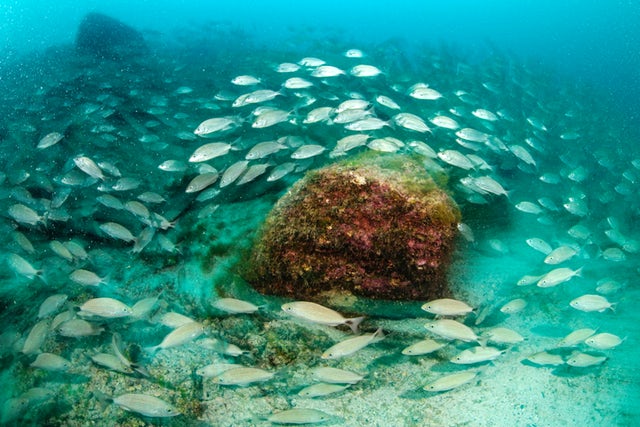 Sound not vision: Hydroacoustics allowed a single researcher to survey the fish population of a 17,600-acre preserve in Mexico in days. The technology could help small island states that are creating big marine protected areas but lack the resources to monitor them.
Sound not vision: Hydroacoustics allowed a single researcher to survey the fish population of a 17,600-acre preserve in Mexico in days. The technology could help small island states that are creating big marine protected areas but lack the resources to monitor them.
IN 2015, A scientist sent sound waves into the waters of Cabo Pulmo National Park in Mexico, single-handedly surveying the entire 27-square-mile (71 square km) marine reserve twice in just eight days. By shooting sound through the water column in horizontal transects and analyzing how the sound waves behaved, the researcher gathered data that he and his colleagues later used to calculate an estimate of how many fish were swimming in the preserve off the tip of Baja California – and their size.
By doing the same thing in the ocean outside the reserve, the researchers determined that the density of fish was nearly 300 percent higher inside Cabo Pulmo. The fish were also 52 percent larger.
This new application of hydroacoustic technology could lead to much cheaper ways of keeping tabs on ocean life, enforcing prohibitions against fishing in marine protected areas (MPAs) and verifying the effectiveness of protecting vast swathes of the sea. The technology also could potentially prove a powerful tool for small island states, which have created large marine reserves in recent years but often lack the resources to monitor them.
The Cabo Pulmo project, detailed in a paper published earlier this month in the journal Scientific Reports, appears to be the first time acoustics have been used to compare marine life inside a reserve to that outside it. Over eight days, a single researcher (plus a boat operator) scanned for fish and other marine life in the park and outside it using a hydroacoustic device called an echosounder that was attached to the vessel. A previous survey by divers took four people six days to survey just 0.1 percent of the park.
“The acoustic surveys took eight days, but we did them with a higher coverage than was strictly necessary, so it could have been done faster,” said Jack Egerton, the study’s lead author, who performed the work while at Bangor University in Wales and who is now a researcher at the University of Texas at Austin’s Marine Science Institute.


 Advertising
Advertising